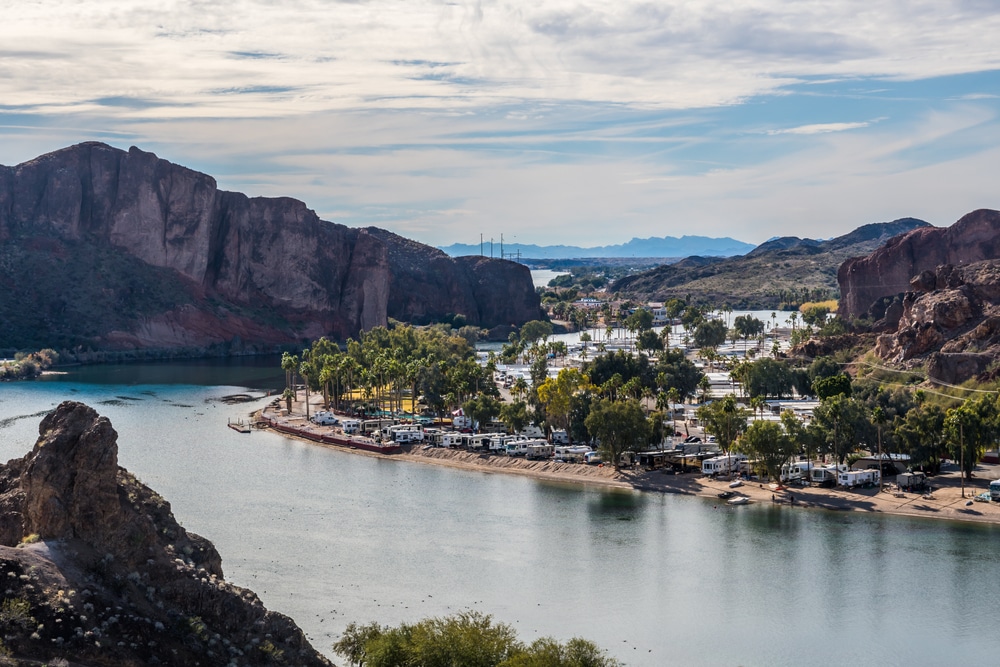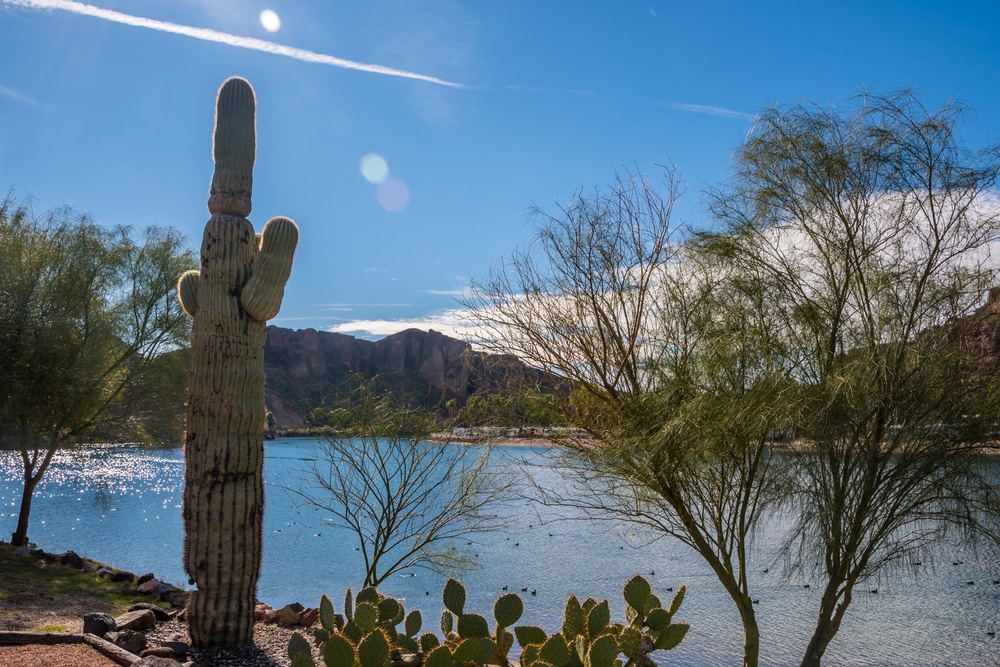Nestled along the Colorado River in western Arizona, Buckskin Mountain State Park offers one of the most picturesque landscapes in the state’s park system. Located approximately 12 miles north of Parker on Arizona Highway 95, this 1,677-acre park commands spectacular views along what’s known as the “Parker Strip” — an 18-mile stretch between Parker Dam and Headgate Dam. The park’s unique position, where rugged desert mountains meet the blue-green waters of the Colorado River, creates a captivating contrast that draws visitors year-round.
Established in 1967 and operated by Arizona State Parks, Buckskin Mountain serves as an ideal destination for those seeking both water recreation and desert adventures. The mountains that line the river on both the Arizona and California sides create a dramatic backdrop, while the diverse wildlife reflects the ecological importance of this river corridor through the arid landscape.

At an elevation of just over 400 feet, the park experiences the typical climate of western Arizona’s lower desert — hot summers and mild winters — making it a popular year-round destination. During summer months, the cool waters of the Colorado River provide welcome relief from the heat, while winter’s mild temperatures create perfect conditions for hiking, fishing, and camping.
Buckskin Mountain State Park’s significance to Arizona’s park system lies in its protection of a crucial stretch of the Colorado River ecosystem while providing sustainable recreational access to one of the state’s most important waterways. The park serves as a gateway to experience both the aquatic pleasures of the river and the rugged beauty of the surrounding Buckskin Mountains, offering visitors an authentic taste of Arizona’s diverse landscapes.
Key highlights include the riverside camping with spectacular mountain views, an extensive network of hiking trails featuring abandoned mine sites and panoramic vistas, and the wealth of water-based activities along one of the most scenic portions of the Colorado River.

Buckskin Mountain State Park offers direct access to the Colorado River with a convenient boat ramp and dock facilities. The river’s calm waters are perfect for motorboating, jet skiing, and water skiing. The channel between Buckskin Mountain and River Island State Park creates an ideal waterway for water sports with scenic mountain backdrops. The park’s location on a significant stretch of the Colorado River provides endless opportunities for exploration by boat.

The Colorado River section at Buckskin Mountain provides excellent fishing opportunities for striped bass, largemouth bass, smallmouth bass, catfish, and rainbow trout. Shore fishing is productive along designated areas, while boat fishing allows access to deeper river channels. Winter months are particularly favorable for trout fishing when water temperatures cool. The park store offers basic fishing supplies and local fishing information.

Several hiking trails wind through the park’s desert landscape, offering spectacular river and mountain views. The Buckskin Trail provides a moderate hike with panoramic vistas of the river corridor and surrounding mountains. The Lightning Bolt Trail climbs to higher elevations with expansive views extending into California across the river. These paths showcase native desert vegetation and geological features characteristic of the region.
Located away from major cities, Buckskin Mountain State Park offers excellent dark sky conditions for astronomy enthusiasts. The minimal light pollution and clear desert air create ideal conditions for observing stars, planets, and celestial events. The open areas near the river provide unobstructed views of the night sky, while the surrounding mountains create dramatic silhouettes against the starry backdrop.

The unique ecosystem where desert meets river creates diverse wildlife habitat. Visitors can observe desert bighorn sheep navigating the steep mountain slopes, while river areas attract various waterfowl and wading birds. Desert mammals including kit foxes, coyotes, and jackrabbits are commonly spotted in early morning and evening hours. The park provides interpretive information about local wildlife and their adaptations to this distinctive environment.

The park features 68 developed campsites that accommodate tents, trailers, and RVs with amenities including water, electricity, fire rings, and picnic tables. Many sites offer river views, with some situated directly on the riverbank. The campground includes modern restrooms with hot showers and a dump station. The combination of desert mountain landscape and river access creates a uniquely appealing camping environment not found in many Arizona parks.

Multiple day-use areas throughout the park offer picnic tables, grills, and shade ramadas with spectacular river views. These facilities are strategically placed to take advantage of scenic vistas and river access, creating perfect settings for family gatherings and outdoor meals. The visitor center provides additional amenities including restrooms and drinking water.
Water activities form the cornerstone of recreation at Buckskin Mountain State Park, with the Colorado River providing a playground for visitors of all ages. The park features a designated swimming area in the day-use section, though swimming is permitted along most of the shoreline (except at boat ramps and around docks). The clear waters make for an inviting swim, particularly during the hot summer months when water recreation becomes the focus for most visitors. It’s worth noting that no lifeguards are on duty, so swimmers enter the water at their own risk.
Boating is extremely popular, with the park offering access to an 18-mile stretch of the Colorado River between Parker Dam and Headgate Dam. A boat ramp within the park provides convenient launching for motorized watercraft including powerboats, jet skis, and personal watercraft. For those who prefer human-powered vessels, the river is also excellent for kayaking and canoeing, with its calm waters and spectacular scenery. Boat rentals are available from outfitters in nearby Parker for visitors who don’t bring their own watercraft.
Fishing opportunities are abundant year-round at Buckskin Mountain. Anglers can target several popular game fish species, including both largemouth and smallmouth bass, which are particularly active in the spring and fall. Catfish and carp provide good bottom-fishing action, while bluegill, sunfish, and crappie are fun catches, especially for younger anglers. Fishing can be productive right from the shore, particularly where aquatic plants grow near the shoreline and around boat docks. Those with boats can access more remote fishing spots along the river. Arizona fishing regulations apply, and a valid Arizona fishing license is required for anglers 10 years and older, available online through Arizona Game & Fish or at local dealers.
Hiking is another major draw at Buckskin Mountain, with the park offering a network of trails ranging from easy walks to more challenging backcountry routes. The most accessible option is the Lightning Bolt Trail, a steep but rewarding half-mile round trip that begins near the park entrance and provides wonderful views of the campground and Colorado River. For those seeking a bit more distance, the one-mile Buckskin Loop Trail connects from the Lightning Bolt Trail and showcases native vegetation with interpretive signs.
A concrete pedestrian footbridge crosses Highway 95, connecting to additional trails on the eastern side of the road. These include the one-mile Interruption Point Trail, which leads to a scenic overlook, and the Copper Mines Trail (approximately half-mile round trip), which passes by a series of abandoned mines that highlight the area’s mining history.
For more adventurous hikers, the Buckskin Trail extends almost 7 miles and includes abandoned mine shafts and rugged backcountry terrain. The Lamb Springs Trail/Abandoned Mine Trail is a moderate 2.3-mile route that actually connects to the nearby River Island State Park, though it includes some isolated sections that require preparation before setting out.
Photography enthusiasts will find countless opportunities at Buckskin Mountain, with the contrast between desert mountains and the blue-green river creating striking compositions. Sunrise and sunset are particularly magical times when the mountains take on golden and rosy hues. Wildlife photography is rewarding as well, especially for bird photographers during migration seasons.
Stargazing benefits from the park’s relatively remote location, with minimal light pollution compared to urban areas. The dark skies reveal impressive star displays, and the mountains create a dramatic silhouette against the night sky. The best stargazing is typically found away from the campground lights in the day-use areas or along the hiking trails (during daylight hours, plan your return before attempting nighttime hiking).
The park also offers more conventional recreation through its basketball and volleyball courts, providing alternative activities when visitors need a break from water and trail adventures.

| Category | Details |
|---|---|
| Location | Parker, Arizona along the Colorado River (Arizona-California border) |
| Area | 1,677 acres (6.8 km²) |
| Elevation | Approximately 440 feet (134 m) |
| Established | Acquired by Arizona State Parks in 1967 |
| Landscape | Desert mountains with dramatic volcanic rock formations |
| Water Features | Located on the Colorado River, specifically the Parker Strip section |
| Facilities | Campground (68 campsites), cabins, boat ramp, beach, picnic areas |
| Camping | RV and tent camping with water and electric hookups at most sites |
| Recreation | Boating, fishing, swimming, hiking, wildlife viewing, stargazing |
| Popular Trails | Lightning Bolt Trail, Buckskin Trail |
| Trail Difficulty | Easy to moderate with some steep, rocky sections |
| Notable Fish Species | Largemouth bass, smallmouth bass, striped bass, catfish, crappie |
| Wildlife | Desert bighorn sheep, coyotes, roadrunners, numerous bird species |
| Plant Life | Saguaro cactus, barrel cactus, ocotillo, paloverde, mesquite |
| Best Time to Visit | Fall through spring (summer temperatures often exceed 110°F/43°C) |
| Nearby Attractions | River Island State Park, Lake Havasu, Bill Williams River National Wildlife Refuge |
| Management | Arizona State Parks & Trails |
| Distance from Phoenix | Approximately 180 miles (290 km) |
| Unique Feature | Offers both mountain desert and riverfront experiences in one park |
The defining natural feature of Buckskin Mountain State Park is undoubtedly the Colorado River, which forms the western boundary of the park and serves as the border between Arizona and California. Here, the river flows through a picturesque canyon with mountains rising dramatically on both sides, creating a ribbon of blue-green water that contrasts beautifully with the surrounding desert landscape.
The Colorado River at Buckskin Mountain is part of the regulated flow between Parker Dam and Headgate Dam. This controlled section creates ideal conditions for recreation while maintaining reliable water levels throughout the year. Visitors should note that water levels fluctuate daily as water is released from the dams, which affects shoreline activities and boat mooring.
Parker Dam, located approximately five miles north of the park, is an engineering marvel worth mentioning. Completed in 1938, it’s often called “the world’s deepest dam” because 73% of its 320-foot height is below the riverbed. This dam was crucial in creating Lake Havasu upstream and regulating the flow of the Colorado River through the region.
The terrain surrounding the park belongs to the Buckskin Mountains, part of a three-range sequence of mildly arc-shaped mountains in the Maria fold and thrust belt region. These mountains were formed through volcanic activity millions of years ago, creating the distinctive rugged landscape visitors see today. The geology features volcanic tuff crossed with deep canyons and sandy washes, providing both scenic beauty and geological interest.
Throughout the park, visitors will encounter a variety of desert landforms, from rocky slopes and ridgelines to sheltered coves along the river’s edge. The Buckskin Mountains extend east from the Colorado River, with colorful rock formations visible from many vantage points within the park. The mountains display a range of earthy hues – reds, browns, and golds – especially striking during sunrise and sunset.
The watershed in this region is particularly significant, as the park is located near where the Bill Williams River joins the Colorado River. The Bill Williams River forms the northern border of the Buckskin Mountains and flows into the Colorado River just a few miles north of the park. This river junction creates a unique riparian zone that supports diverse plant and animal communities not typically found in desert environments.
Despite the arid conditions, the presence of the Colorado River creates a desert oasis effect, supporting a narrow band of riparian habitat along its shores. This combination of desert and riparian ecosystems makes Buckskin Mountain State Park an excellent location for observing the complex interaction between water resources and desert landscapes in the American Southwest.
Buckskin Mountain State Park showcases the fascinating intersection of desert and riparian ecosystems, creating a diverse habitat for plants and wildlife. The park’s location along the Colorado River provides a vital water source in an otherwise arid landscape, supporting a variety of species adapted to these unique conditions.
The plant life at Buckskin Mountain reflects the Sonoran Desert ecosystem with some notable adaptations. Along the higher elevations and slopes, visitors will encounter typical desert vegetation including creosote bush, ocotillo, various cacti species, and desert shrubs. One of the more unique botanical features is the presence of isolated saguaro cacti—a rarity in this part of Arizona, especially at this low elevation. These iconic desert sentinels can be spotted along some of the hiking trails, particularly along the River View Trail.
Near the river’s edge, the vegetation changes dramatically to reflect the availability of water. Cottonwood trees, willows, and mesquite can be found in this riparian zone, providing crucial shade and habitat. These water-loving plants create a stark contrast to the drought-resistant species found just a short distance away on the higher slopes. The park offers a trail guide corresponding to numbered posts that highlights native vegetation, available at the Ranger Station for visitors interested in learning more about the plant communities.
Wildlife viewing opportunities abound at Buckskin Mountain, with the diverse habitats supporting an impressive array of animals. Mammals frequently spotted in the park include bobcats, ringtail cats, coyotes, and gray foxes, which often shelter in the bushy washes along the river shoreline. Desert bighorn sheep sometimes populate the cliffs and mountainous areas above the river, though they can be elusive. Smaller mammals like rabbits, beavers, and various rodent species are also common residents.
Bird watchers will find Buckskin Mountain particularly rewarding, as both resident and migratory species utilize the Colorado River corridor. Commonly observed birds include red-tailed hawks, Vermillion flycatchers, great horned owls, and burrowing owls. Along the river, visitors might spot egrets, herons, and various waterfowl. During migration seasons, the variety increases substantially as birds use the river as a navigational landmark and stopover point.
Reptiles are well-represented in the park’s ecosystem, adapted to the heat and arid conditions. Desert lizards like the desert iguana and collared lizard are frequently encountered along trails and rocky areas. Snake species include the non-venomous coachwhip (also known as the red racer) and king snake.
Seasonal ecological changes at Buckskin Mountain are most evident in spring when desert wildflowers can create colorful displays, particularly after wet winters. The Lightning Bolt Trail is known for its spring wildflower viewing opportunities. Summer brings higher temperatures that drive many animals into shade or nocturnal activity patterns, while the cooler temperatures of fall and winter result in more daytime wildlife activity.
The Colorado River itself supports a healthy aquatic ecosystem with various fish species that attract both wildlife and human anglers. Osprey and other fishing birds can sometimes be spotted hunting along the river, showcasing the ecological connections between the water and surrounding landscape.
The park’s Visitor Center includes informative exhibits about local flora and fauna, and rangers are knowledgeable about recent wildlife sightings and seasonal highlights, making it a good first stop for visitors interested in nature observation.
Camping at Buckskin Mountain State Park offers an immersive experience where visitors can fall asleep to the gentle sounds of the Colorado River and wake up to dramatic mountain views. The park’s campground features 68-80 camping and RV sites (counts vary slightly by source), many within close proximity to the river and some directly on the water’s edge.
The campsites are designed to accommodate a variety of camping styles. All sites include basic amenities such as a picnic table and BBQ grill, making meal preparation convenient. Most sites offer water and 30-amp electrical hookups, while approximately 15 sites provide full hookups with sewer connections. This variety allows campers to choose the level of amenities that best suits their needs, from more rustic experiences to those with full RV connections.
For RV campers, Buckskin Mountain is particularly accommodating, with no posted maximum length restrictions at most sites (though sites 69-84 have a maximum parking length of 24 feet). The park’s layout generally provides spacious sites compared to many other campgrounds, giving RV campers room to spread out without feeling crowded next to neighboring sites.
Tent campers have several options as well. While they can use the standard campsites, the park also offers 21 waterfront cabana sites that are especially appealing for tent camping. These cabanas feature two and a half walls, a concrete floor, a roof, and a 15-amp electrical outlet. Tents can be pitched on the ground between the cabana and the river, providing an excellent riverside camping experience with some added comfort and shade.
Campsite reservations are recommended year-round and can be made online or by calling the Arizona State Parks Reservations Desk at 1-877-MY-PARKS (697-2757). Fees range from $35-$45 per night depending on the site, with an additional non-refundable reservation fee of $3.60 per site. An extra vehicle fee of $15 applies for additional vehicles beyond the first. It’s worth noting that during the April-June 2025 construction period, campsite availability may be reduced.
The maximum stay at a specific site is typically 14 days, though this limit may be extended with permission from the Park Manager. Park regulations allow campers to move to a different site after their 14-day limit for an additional stay.
Amenities for campers include three restroom buildings with clean, hot showers (though some visitors note the water gets only warm, not hot). A dump station is available for registered campers, and dishwashing stations provide a convenient way to handle cleanup after meals. Wi-Fi service is available, though it’s limited to the area around the ramada and can be spotty.
For visitors who prefer not to camp but want to stay nearby, alternative accommodations can be found in Parker (12 miles south) and Lake Havasu City (approximately 25-30 miles north). These range from budget motels to more upscale hotels and resorts, particularly in Lake Havasu City.
Camping regulations include quiet hours from 10 PM to 7 AM, with all music and generators required to be off during this time. Pets are welcome but must be leashed and attended to at all times, with leashes not exceeding six feet in length. Pets are only allowed on the north beach area.
Those looking for a group camping experience should check out the nearby River Island Unit, about one mile north of the main park. This area offers a ramada with a campfire ring that can be reserved for group use (except on holiday weekends), providing a great option for family reunions or other gatherings.
Operating hours at Buckskin Mountain State Park accommodate both day visitors and overnight campers. The Ranger Station is open daily from 8:00 AM to 4:00 PM, while the park itself is accessible 24 hours a day for registered campers. Day use hours run from 8:00 AM to 10:00 PM, giving visitors ample time to enjoy the park’s amenities.
Entrance fees are structured as follows: Day use costs $10.00 per vehicle with one adult or $20 per vehicle with 2-4 adults. Campsite check-in begins at 2:00 PM Arizona time, with checkout strictly enforced at 12:00 noon. Campers arriving before noon on their check-in day will be charged the park entrance fee in addition to their camping fees.
For those planning multiple visits to Arizona State Parks, annual passes are available. Arizona offers a non-commercial standard pass for weekday use at all parks (including weekends at most parks) and a premium pass that includes weekend and holiday access.
Summer (June through September) brings intense heat, with daytime temperatures regularly exceeding 100°F, making water activities the most comfortable option. During these months, hiking is best done in the early morning hours.
Spring (March through May) and fall (October through November) offer more moderate temperatures, ideal for enjoying the full range of park activities. Spring visits may coincide with desert wildflower blooms, particularly after wet winters.
Winter (December through February) features mild daytime temperatures in the 60-70°F range, perfect for hiking and fishing, though nights can be cool, dropping into the 40s.
Weather patterns in this low desert region are characterized by extremely hot, dry summers and mild winters. Rainfall is minimal throughout the year, with occasional winter storms bringing the majority of annual precipitation. Visitors should always prepare for the desert environment with plenty of water, sun protection, and awareness of heat-related hazards during warmer months.
Access to Buckskin Mountain State Park is straightforward via Arizona Highway 95, approximately 12 miles north of Parker or about 30 miles south of Lake Havasu City. The park’s address is 5476 N. US Hwy. 95, Parker, AZ 85344, and GPS coordinates are 34.256389°N, 114.136389°W.
Accessibility information indicates that the park has made efforts to accommodate visitors with mobility challenges. One of the three restroom and shower buildings is handicap accessible, and the visitor center is also accessible. Some trails and the beach areas may present challenges for those with limited mobility due to uneven terrain.
Pet policies allow leashed dogs in the park, provided they are attended to at all times and leashes do not exceed six feet in length. Pets are welcome at campsites but are limited to the north beach area only when it comes to waterfront access.
Cell service and internet availability vary throughout the park. WiFi is provided at the group ramada at no charge, but service can be spotty and is generally only reliable when sitting close to the ramada. Cell phone reception is available but may be limited in some areas due to the surrounding mountains.
Visitors should note that a construction project is scheduled for April through June 2025, which may reduce campsite availability. During this period, boat launch access for campers will be available at River Island State Park, 1.5 miles adjacent to the main park.
The Buckskin Mountain State Park Visitor Center serves as the information hub for park activities and features informative exhibits about the local flora, fauna, and history of the area. Inside, visitors will find an exciting video library, a book exchange, and plenty of resources about the surrounding region. Park rangers and volunteers staffing the center are knowledgeable about current conditions and wildlife sightings, making this an excellent first stop upon arrival. From January through March, the park offers interpretive programs and ranger-led hikes starting from the Visitor Center.
Restroom and shower facilities include three regularly maintained buildings throughout the park, with one being handicap accessible. All feature clean, hot showers available to registered campers, though some visitors note that the water temperature may be more warm than hot. The shower buildings also include electrical outlets for hair dryers and other personal care appliances.
Picnic areas provide opportunities for day visitors to enjoy meals with a view. The main day use area is located northwest of the Contact Station and features a grassy space with shade trees overlooking the Colorado River. This area includes picnic tables and two large BBQ grills, making it perfect for family gatherings or small group outings. Parking is available for 28 vehicles, with 12 spots able to accommodate vehicles towing small boat trailers.
The boat ramp provides convenient water access for those bringing watercraft. While construction is planned for April through June 2025, which may affect boat launch access at the main park, alternative launching is available at the nearby River Island State Park just 1.5 miles away.
Specialized recreation areas include basketball and volleyball courts, offering alternatives to water and trail activities. A playground provides entertainment for younger visitors, making the park family-friendly for all ages.
For visitor convenience, the Buckskin Market operates within the park (closed during winter months) and includes a restaurant, an arcade, and a store selling firewood, ice, food, and gasoline. This concessionaire-operated facility ensures that campers have access to basic supplies without needing to leave the park.
Additional amenities include a dump station for use by registered overnight campers (no dump or fill permitted for unregistered campers) and a gas dock for boaters. Fire rings are available at all campsites, though ground fires are prohibited; all fires must be contained in grills or portable fireplaces.
The park has taken steps to ensure safety and comfort, with rules designed to maintain the natural environment while providing a positive experience for all visitors. Quiet hours from 10 PM to 7 AM help ensure peaceful nights, and regulations regarding pets, fires, and watercraft operation are clearly posted throughout the park.
For those interested in learning more about the natural environment, the park offers trail guides corresponding to numbered posts along several hiking routes, highlighting native vegetation and points of interest. These can be obtained at the Ranger Station and provide educational context to enhance the hiking experience.
The region surrounding Buckskin Mountain State Park offers numerous additional attractions that can enhance a visit to the area. Within a short drive, visitors can explore natural wonders, historical sites, and other recreational opportunities.
Just one mile north of Buckskin Mountain lies River Island State Park, which serves as an excellent companion destination. This park unit is ideal for tent campers and offers 37 campsites, a ramada, sandy beach, cove, and boat launch area. The Habitat Trail at River Island is particularly interesting, featuring a guide narrated from “Arnie Ant’s” perspective about life on the Colorado River. This one-mile round trip trail is quite steep but offers fantastic views of the surrounding mountains and Parker Dam.
Parker Dam, located approximately five miles north of Buckskin Mountain on Highway 95, is often called “the world’s deepest dam.” Completed in 1938, this engineering marvel stands 320 feet high, with 235 feet (73%) of its structure below the riverbed. The dam created Lake Havasu and continues to regulate water flow along the Colorado River. A visit provides insight into the region’s water management history and the complex system that transformed this desert region.
Bill Williams National Wildlife Refuge lies about 8-10 minutes north of the park, where the Bill Williams River meets the Colorado River. This protected area offers sanctuary to numerous migratory and resident birds as well as diverse fish and wildlife. One of its most significant conservation achievements is preserving one of the last naturally regenerated cottonwood-willow forests along the Lower Colorado River, providing a glimpse into what the landscape looked like hundreds of years ago. The Peninsula Trail within the refuge is approximately 1.2 miles out and back, with paved sections and ramada spots for fishing and river observation.
Lake Havasu City, approximately 25-30 miles north, is home to the famous London Bridge—an actual historic bridge from London, England that was purchased, dismantled, and reassembled in Arizona. Completed in 1971, the bridge links an island in the Colorado River with the main part of Lake Havasu City and has become an iconic tourist attraction. The city also offers additional shopping, dining, and accommodation options for those looking to extend their stay in the region.
The Colorado River Indian Reservation is located just east of Parker and is home to four tribes: the Mohave, Chemehuevi, Hopi, and Navajo. In Parker, visitors can explore the CRIT Museum (Colorado River Indian Tribes Museum), which preserves tribal artifacts and traditions. Checking their calendar of events might reveal opportunities to see tribal artisans creating traditional artworks.
For desert exploration, the Gibraltar Mountain Wilderness is located about 10 miles northeast of Parker in the western Buckskin Mountains. This 18,790-acre property features volcanic tuff crossed with deep canyons and sandy washes, providing opportunities for more remote hiking and wildlife viewing.
Local businesses in Parker offer services that complement a park visit, including boat rentals for those who don’t bring their own watercraft. The Parker Area Chamber of Commerce can provide additional information about local attractions, dining options, and events.
Those interested in more water recreation can visit other nearby Arizona State Parks along the Colorado River, including Lake Havasu State Park and Cattail Cove State Park, both located north of Buckskin Mountain. Each offers its own unique attractions while providing additional opportunities for camping, boating, and fishing.
The nearby Havasu National Wildlife Refuge, established by Executive Order by President Franklin D. Roosevelt in 1941, encompasses 37,515 acres along the Colorado River in Arizona and California. The refuge protects 30 river miles and 300 miles of shoreline, including the 20-mile long Topock Gorge, one of the last remaining natural stretches of the lower Colorado River.
Buckskin Mountain State Park plays an important role in conserving a critical section of the Colorado River ecosystem while providing sustainable recreational access. The park’s management balances visitor enjoyment with protection of natural and cultural resources, ensuring this desert oasis remains vibrant for future generations.
The Colorado River corridor protected by the park represents a crucial riparian habitat in an otherwise arid region. These riverside environments support diverse plant and animal communities and serve as important migration corridors for birds and other wildlife. By maintaining this stretch of river in a natural state, the park helps preserve biodiversity in western Arizona.
Visitors to Buckskin Mountain can contribute to conservation efforts by practicing responsible recreation. Following established park rules regarding waste disposal, pet management, and staying on designated trails helps minimize human impact on sensitive desert and riparian ecosystems. The park encourages visitors to pack out what they pack in and to use designated facilities for waste disposal, including the dump station for RV campers.
Water conservation is particularly important in this desert environment. The park has implemented restrictions on vehicle and RV washing, and prohibits portable spas, pools, and mist systems to conserve this precious resource. These measures reflect the broader water management challenges facing the Colorado River basin, where demand often exceeds supply.
Educational programs offered at the park, particularly during the January through March period, help visitors understand the ecological significance of the area and the importance of conservation. Ranger-led hikes provide opportunities to learn about native species, geological features, and the human history of the region, fostering an appreciation for the park’s natural and cultural heritage.
The park’s visitor center includes exhibits highlighting local ecology and conservation initiatives. These educational resources help connect visitors to the landscape and encourage stewardship behaviors. Trail guides available at the Ranger Station provide similar educational content along hiking routes, allowing visitors to learn while exploring.
For those interested in more direct involvement, volunteer opportunities may be available through Arizona State Parks. Volunteers can contribute to park maintenance, visitor services, and conservation projects, making a tangible difference in preserving this special place.
Leave No Trace principles are encouraged throughout the park, with an emphasis on minimizing impact in all activities. These include planning ahead and preparing properly for desert conditions, disposing of waste properly, leaving natural and cultural features as found, respecting wildlife by observing from a distance, and being considerate of other visitors.
The park also connects to broader conservation efforts in the region, including the nearby wildlife refuges that protect additional sections of the Colorado River ecosystem. These protected areas work together to maintain wildlife corridors, preserve habitat diversity, and ensure the health of the river system.
By visiting Buckskin Mountain State Park and supporting Arizona State Parks through entrance fees and camping reservations, visitors contribute financially to ongoing conservation and maintenance efforts. This funding helps ensure that the park’s natural and recreational resources remain available for current and future generations to enjoy.
Through these combined efforts—responsible visitor behavior, educational outreach, volunteer opportunities, and sustainable management practices—Buckskin Mountain State Park continues to protect its unique desert-meets-river ecosystem while providing meaningful connections to nature for all who visit.